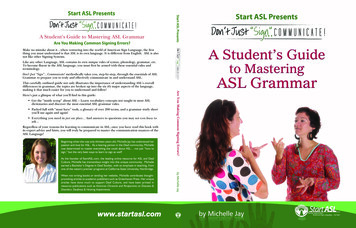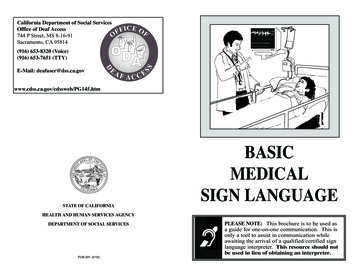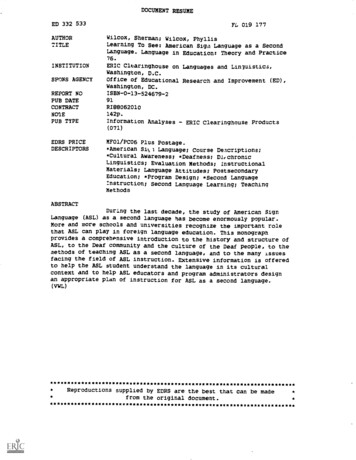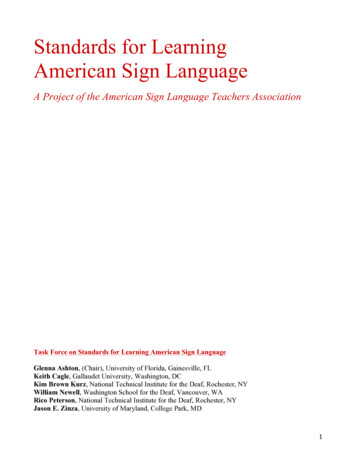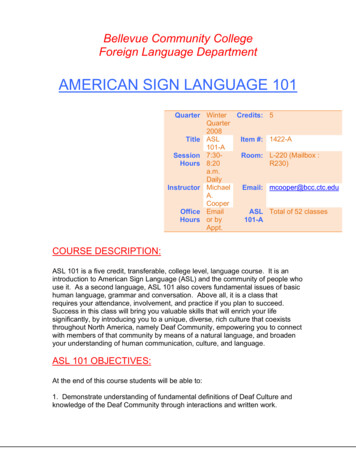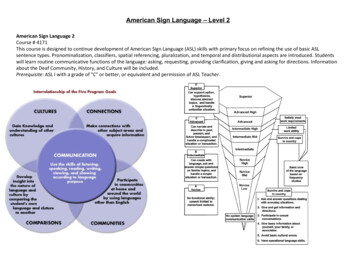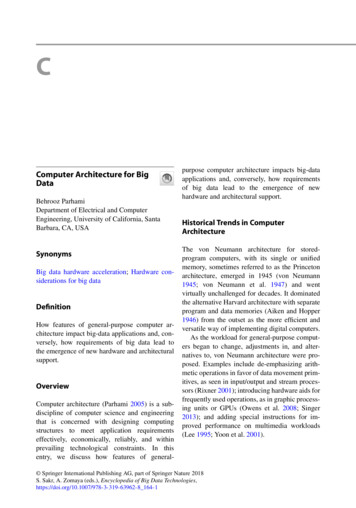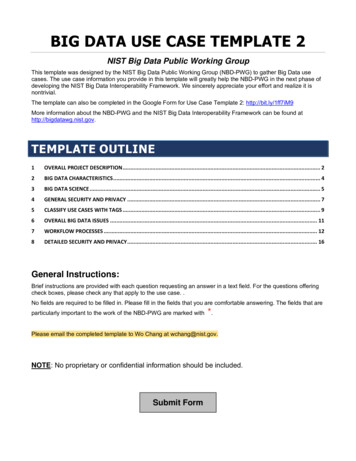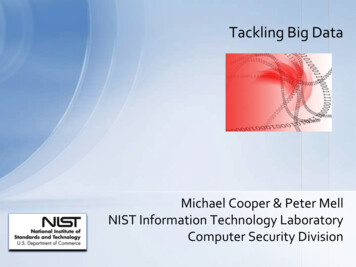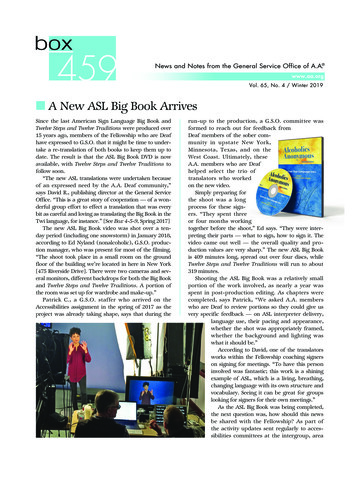
Transcription
News and Notes from the General Service Office of A.A. www.aa.orgVol. 65, No. 4 / Winter 2019n A New ASL Big Book ArrivesSince the last American Sign Language Big Book andTwelve Steps and Twelve Traditions were produced over15 years ago, members of the Fellowship who are Deafhave expressed to G.S.O. that it might be time to undertake a re-translation of both books to keep them up todate. The result is that the ASL Big Book DVD is nowavailable, with Twelve Steps and Twelve Traditions tofollow soon.“The new ASL translations were undertaken becauseof an expressed need by the A.A. Deaf community,”says David R., publishing director at the General ServiceOffice. “This is a great story of cooperation — of a wonderful group effort to effect a translation that was everybit as careful and loving as translating the Big Book in theTwi language, for instance.” [See Box 4-5-9, Spring 2017]The new ASL Big Book video was shot over a tenday period (including one snowstorm) in January 2018,according to Ed Nyland (nonalcoholic), G.S.O. production manager, who was present for most of the filming.“The shoot took place in a small room on the groundfloor of the building we’re located in here in New York[475 Riverside Drive]. There were two cameras and several monitors, different backdrops for both the Big Bookand Twelve Steps and Twelve Traditions. A portion ofthe room was set up for wardrobe and make-up.”Patrick C., a G.S.O. staffer who arrived on theAccessibilities assignment in the spring of 2017 as theproject was already taking shape, says that during theF-36 Box 4-5-9 Winter 2019.indd 1run-up to the production, a G.S.O. committee wasformed to reach out for feedback fromDeaf members of the sober community in upstate New York,Minnesota, Texas, and on theWest Coast. Ultimately, theseA.A. members who are Deafhelped select the trio oftranslators who workedon the new video.Simply preparing forthe shoot was a longprocess for these signers. “They spent threeor four months workingtogether before the shoot,” Ed says. “They were interpreting their parts — what to sign, how to sign it. Thevideo came out well — the overall quality and production values are very sharp.” The new ASL Big Bookis 409 minutes long, spread out over four discs, whileTwelve Steps and Twelve Traditions will run to about319 minutes.Shooting the ASL Big Book was a relatively smallportion of the work involved, as nearly a year wasspent in post-production editing. As chapters werecompleted, says Patrick, “We asked A.A. memberswho are Deaf to review portions so they could give usvery specific feedback — on ASL interpreter delivery,language use, their pacing and appearance,whether the shot was appropriately framed,whether the background and lighting waswhat it should be.”According to David, one of the translatorsworks within the Fellowship coaching signerson signing for meetings. “To have this personinvolved was fantastic; this work is a shiningexample of ASL, which is a living, breathing,changing language with its own structure andvocabulary. Seeing it can be great for groupslooking for signers for their own meetings.”As the ASL Big Book was being completed,the next question was, how should this newsbe shared with the Fellowship? As part ofthe activity updates sent regularly to accessibilities committees at the intergroup, area11/4/19 12:22 PM
Box 4-5-9 is published quarterly by the General ServiceOffice of Alcoholics Anonymous, 475 Riverside Drive,New York, NY 10115, copyright 2019 by AlcoholicsAnonymous World Services, Inc.Mail address: P.O. Box 459, Grand Central StationNew York, NY 10163G.S.O.’s A.A. Website: www.aa.orgSubscriptions: Individual, 3.50 per year; group, 6.00for each unit of 10 per year. Check—made payable toA.A.W.S., Inc.—should accompany order. To have issuesdelivered directly to your inbox, register your email onthe A.A. Digital Subscription Service on G.S.O.’s Website.Note on anonymity: From time to time in thispublication, full names and/or pictures of G.S.O.employees, Class A trustees and other nonalcoholics areused. The anonymity of A.A. members is maintained,as they are identified throughout by first name and lastinitial only and do not appear in photos.and district levels, Patrick says, “We included twoshort ASL videos as links to convey information aboutthe new translations.” (A third installment accompanied a Public Information press release as the BigBook was finalized. The full press release, in ASL,can be accessed on G.S.O.’s website at www.aa.org/BigBookASLpressrelease.)Published on DVD, the new ASL Big Book includessubtitles and an audio track and can be viewed onaa.org as well as A.A.W.S.’s YouTube channel.“We believe this project has been done with the righttranslators, in the spirit of A.A,” says Patrick. “We’rehopeful that it will be a tool to help more memberswithin the A.A. community who are Deaf and to helpthose alcoholics who are Deaf and are still out theresuffering.”As an addendum, a new intergroup website has beenlaunched in Central Texas to serve A.A. members whoare Deaf. As noted in their mission statement, “The A.A.Deaf Intergroup of Central Texas [https://centexdeafintergroup.org] is a service entity established pursuantto Tradition Nine of Alcoholics Anonymous to operateon behalf of the participating A.A. groups in accordancewith A.A.’s Twelve Traditions and Twelve Concepts.The A.A. Deaf Intergroup exists to aid the A.A. groupsin their common purpose of carrying the A.A. messageto the alcoholic who still suffers by increasing accessibility to A.A. meetings for Deaf people in recovery.“Deaf and Hard-of-Hearing A.A. members needthe Fellowship’s assistance in order to both receivethe message and be able to interact with other A.A.members and be a part of the group. The A.A. DeafIntergroup of Central Texas exists in order to fosterrelationships between the hearing and Deaf A.A. members and ensure consistency of A.A. meetings with qualified interpreters. As one of our members has statedin the past, ‘We are to Deaf A.A. members, what otherIntergroups are to hearing A.A. members.’”2F-36 Box 4-5-9 Winter 2019.indd 2For more information about A.A. resources for alcoholics who are Deaf or Hard-of-Hearing, contact theAccessibilities and Remote Communities Coordinator atthe General Service Office at access@aa.org or by phoneat 212-870-3344.n ASL Videos to BeMade Available from2020 International ConventionA request made by a women’s group in a correctionalfacility in Area 73, West Virginia, to film ASL translators for the first time ever in those meetings at the 2020International Convention that will have ASL translation— and make the videos available for sale post-Convention, just as is done with audio recordings — wasapproved by the General Service Board in January 2017.This will help to expand A.A.’s accessibility effortsand greatly broaden the reach of the InternationalConvention to members and potential members whodepend on ASL for their communications. G.S.O. staffwill work with the same vendor that will be producingthe audio tapes for the Convention (slated for July 2-5in Detroit, Michigan) and plans for the filming andimplementation are currently underway.n With an Eye to the Future:G.S.O. Staff PositionsWe are beginning to update our file of applicationsfrom A.A. members who are interested in being considered for possible future openings for the position ofG.S.O. staff member. The basic criteria include a minimum of six years continuous sobriety; a backgroundin service at the group and possibly district and arealevels; business or professional experience; and excellent communication skills. Another consideration is awillingness to relocate to New York, if necessary. G.S.O.staff people are A.A.s who carry out rotating assignments and correspond with A.A.s throughout the worldon all aspects of recovery and service. Additionally,they represent G.S.O. at A.A. functions throughoutthe U.S. and Canada and provide the primary staffsupport for the General Service Board. Currently thereare 13 staff members who cover a variety of assignments such as: Accessibilities/Remote Communities,Public Information, Literature, Cooperation with theProfessional Community, Corrections, International andthe General Service Conference. If you are interestedor would like more information, please write to: StaffCoordinator, Box 459, Grand Central Station, New York,NY 10163 or email staffcoord@aa.org.Box 4-5-9, Winter 201911/4/19 12:22 PM
n NAATW and TIAA:Grassroots Sharing on A.A. and TechnologyThis article is the second of three in a Box 4-5-9 series on the technology that is changing the way Alcoholics Anonymouscommunicates to suffering alcoholics and interacts with its members.“Imagine,” says Lew G., aco-founder of the online forumTechnology in A.A. (TIAA),“an international society withtwo million members with,conceivably, as many as 10,000web presences that don’t coordinate with each other, thatsometimes provide conflicting information, that are slowto update and that are oftendependent on someone’s nieceor brother-in-law to fix whenthey get broken.”What you’ve imagined, of course, is AlcoholicsAnonymous, which has beenrepresented by a hodgepodge of different websitesfor groups, districts, areas andintergroup/central offices. While this has worked, moreor less, for a while — “and in a certain sense, is in accordance with A.A. and our Tradition of group autonomy,” Lew says — there have been ongoing problems interms of people showing up at the wrong places andthe wrong times for meetings in new places, or findingreliable contacts when they needed another alcoholic tospeak to. Lois L., an administrator on the TIAA onlineforum and a professional digital strategist and userexperience (UX) consultant who advises G.S.O., echoesthis: “Someone can create a website and then go outand drink, or just disappear, and there’s no way to fixor update it because of credentials and password issues.Sometimes these are sites containing important archivecollections that go dark and what’s on them is lost.”It’s long been apparent to a number of A.A. members, both with and without tech backgrounds, thatthere has to be a way to share technology withinAlcoholics Anonymous so that every new webmasterdoesn’t have to reinvent the wheel and, even moreimportantly, so that fresh ideas on how to use tech tospread the message to suffering alcoholics can comebubbling to the surface.One answer came in August of 2014, which sawthe very first meeting of the National A.A. TechnologyWorkshop (NAATW). NAATW was the brainchild ofBrouck H. and Blaine B., both of whom work in the techindustry and have advised the General Service Office ontechnology. Brouck consulted with G.S.O. to fix problems with the e-reader app, released in 2012. The teamBox 4-5-9, Winter 2019F-36 Box 4-5-9 Winter 2019.indd 3he put together included Blaine. Their work made themrealize how much needed to be done as A.A. inevitably,but slowly, moved forward into a technological age.And so they began giving workshop forums on theirown, both in the U.S. and in Canada, many of them tointergroup office managers — intergroup/central officesbeing on the front line of communicating with membersand active alcoholics seeking help.“One of the issues that was important,” Brouck says,“is that we presented tech issues from the perspectiveof A.A. members — not outside vendors. In talkingto people, we understood what they were up againstand why it was so difficult to get answers to some ofthe technological questions they had. We realized thatthere had to be more communication, more sharing,so we thought, How do we organize this and make ithappen?”The answer was NAATW, which they based onthe model of the National A.A. Archives Workshop(NAAAW). Attendees at that first St. Louis Workshop— such as Lois L., who became an NAATW steeringcommittee member — spoke to the fact that there wasno general role in A.A. for focusing on technology. Theyalso addressed the concern that service in tech wouldrequire special knowledge, leaving A.A. dependent on acadre of expert technologists — a situation that wouldrun counter to the spirit of rotation, a central principleof the NAATW. Published on their website, (https://naatw.org/12-statements-of-technology/) NAATW’s “12Statements of Technology” begin with implementing311/4/19 12:22 PM
technology “where it supports our primary purpose,”making an informed group conscience “a part of technology decision making,” and using technology “tomake information available, not limit it.”NAATW has continued to do just that as it grows. Itslatest workshop was held in Bowling Green, Kentucky,in September 2019, and it will host a hospitality suite atthe International Convention in Detroit next summer.“When it comes to spreading the message about howto use tech,” Brouck says, “we are agnostic about platforms. The real issues are: Is it stable? Can you affordit? Is support available? And is it adaptable withoutwriting your own code? That’s the fundamental outlineof it for most A.A. entities.”Aiding in this work of spreading the message abouttechnology are Lew G. and his TIAA co-founder KeithD., who has spent a career working in IT and was aPanel 67 delegate for Area 65 in Northeast Texas. TheTIAA forum — intended expressly for both technicaland non-technical members — began out of a need tokeep ideas percolating all year-round between NAATWconferences in order to share questions and solutions oneverything from how to support new websites to findingthe best answering service for your district. It now hasmore than 700 members and, as of August 1, a boardof directors, president, secretary, treasurer and 501c3nonprofit status. Interested members can sign up attiaa-forum.org.“What’s exciting is to see new members come on andget some of the answers they need,” Lew says. “I’d liketo expand our How-to sections to give incoming members easier access to basic information they need to create a website. We’ve had subgroups go off and do actual development and code for the forum and for A.A. asa whole.” A recent visit to the “Forum” page revealedsubstantive threads on a broad range of subject matter— everything from archiving your A.A. archives website to the best apps for recording speakers to changingyour website’s domain name system settings. AddsLew, “One of the biggest successes for us has been theMeeting Finder app [See Box 4-5-9, Fall ’19], whosedeveloper Josh R. received support and feedback fromthe forum and from NAATW. Josh came out of thiscommunity. Hopefully, the next great app or web development can arise out of some email interchange here ormembers having coffee somewhere.”Clement C., staff member on the CommunicationServices assignment at the General Service Office, is aTIAA forum member and regularly attends NAATWforums, as does Julie Gonzalez (nonalcoholic),Communication Services staff assistant. He emphasizesthat he and Julie don’t participate in the workshops oron the forum as official voices of G.S.O. “There is noofficial connection, but we listen.” In the first NAATWconference he attended, Clement noted that G.S.O. wasin the process of drafting a request for proposal (RFP)4F-36 Box 4-5-9 Winter 2019.indd 4for the new G.S.O. website that is currently in developtment, adding, “Before the weekend was over, I hada seven-page report with suggestions on how to craftit.” As A.A. continues with its YouTube channel, theMeeting Finder app, the new website and any numberof forthcoming projects, Clement says, “There havebeen people who came out of NAATW/TIAA helpingevery step of the way.”“The thing that was exciting to me at the NAATWforum [in Bowling Green],” Julie says, “was people’sreactions to solutions they are hearing. That look ofrelief that we can make this work. People get fired upand excited. They got emotional during a session onhow people are using video-conference software tohold remote meetings.” And both Lois and Brouck pointto simultaneous phone-translating software that canallow meetings to be held remotely in a host of differentlanguages, with anonymity intact, as among a numberof innovations that will help spread the word of A.A. inthe not-too-distant future.In practice, how will the growth of tech work inA.A.? Blaine B., co-founder of NAATW, sounds a cautionary note: “The more we make this about technicalexpertise, the more it scares people off. It’s regular A.A.service work. People always say, ‘I’m not very technical,’but for the most part, that’s not what this is. Much ofwhat we communicate is very low tech, stuff that people can do from simple little recipes, as it were. So, it’sa mistake to attach some kind of mystique around itthat makes it seem unapproachable or more difficultthan it is.”Keith D., now a member of the NAATW steeringcommittee, takes a nuanced view of how tech candevelop within A.A. principles. “Showing someoneon a how-to TIAA board steps to build a website inWordPress is not that hard. If you can use a computerfairly well, you can do it. Most webmasters in this sense,with a little help, can rotate in and out of positions on aregular basis. But there are more technical service jobswhere someone with IT expertise is needed. Sometimesthat person, like certain archivists, may be in the job foryears. And sometimes districts may need to pay peoplefor specialized expertise. None of this is new.”In the end, Keith feels, “The point is that we are goingin the right direction or at least the conversation is goingin the right direction. I love A.A. and it has changed mylife. The Language of the Heart is a book I read a lot,and through it I’ve gotten pretty familiar with Bill W.’sviewpoint. I’m willing to bet if he were alive today, he’dsay, ‘Oh my God, let’s see how we can use this to makeA.A. more effective.’ We may screw up, and we’re goingto fall on our faces, just like we do during our recoveries.But then we use that experience to get better.”The 2020 NAATW will be held in Greater Seattle.For more information and to sign up for the NAATWnewsletter, visit naatw.org.Box 4-5-9, Winter 201911/4/19 12:22 PM
n Women in A.A. — Leaders of Today and YesterdayEarly A.A. experience is filled with stories of struggle,hope, redemption and freedom from our commonaffliction of alcoholism. Early accounts by women —their struggles with alcohol, their freedom from it andtheir subsequent newfound “usefulness,” both in theirpersonal and public lives — may not be exactly abundant, but they do exist, and many of us know theseearly female A.A.s by name or by story.Appearing in the Big Book’s First Edition, the story“A Feminine Victory” is one such account. Though thiswoman’s narrative does not appear in subsequent editions, her story had a critical impact: it helped compelanother early alcoholic woman, Marty M., to take herfirst hopeful steps into a 1939 meeting at Bill and Lois’sBrooklyn brownstone. Marty M., of course, went onto become the founder of the NationalCommittee for Education on Alcoholismand a national force in the understanding and treatment of alcoholism. Shedevoted her life to spreading information about alcoholism and fighting thestigma attached to it. Marty’s tirelesswork and her public identification asa female alcoholic threw many A.A.meeting doors wide open to women. Notunexpectedly, in subsequent editions ofAlcoholics Anonymous, women beganto appear more in the stories that followthe first 164 pages. And, if they weren’texactly crowding the pages, their presence and voice were growing.Published in 1960 to commemorateA.A.’s 25th anniversary, the Grapevinepublication AA Today contains a storywritten by Marty M. titled “For MenOnly?” In it, she writes about the difficulty she encountered in her first yearof A.A. because she was a “womanalcoholic.” Certain that she was not theonly woman suffering from alcoholismand hoping fervently that A.A. couldwork for women, she made it her “selfappointed task of getting women intoA.A.” Following through on this turned out to be farfrom easy, but Marty was up to the challenge. “I hadplenty of prospects but few results. All that long hotsummer I went into New York once a week to the meeting, hoping a woman might appear, find me, know thatshe was not alone and unique, and stay.” After searching long and hard, she says, she finally found two otherwomen alcoholics. She was elated. “Now there werethree of us the country over — but three is a crowd.Three can be neither alone nor unique, and we were allthree too different to be the same kind of freak!”Box 4-5-9, Winter 2019F-36 Box 4-5-9 Winter 2019.indd 5These first A.A. women were crucial to the earlymovement of Alcoholics Anonymous, and a greatmany of us are also familiar with the names of A.A.’s“friends” who were women — nonalcoholics suchas Sister Ignatia, Lois W., Anne S., Ruth Hock andHenrietta Seiberling. Their names have gone downin the annals of our history. But not all the names ofA.A.’s female nonalcoholic friends are so familiar.One such woman who served the Fellowship in itsearly years was Margaret Farrand, who holds thedistinction of being A.A.’s first female trustee, having served on the board of the Alcoholic Foundationfrom 1941 to ’44. Wife of a former Cornell Universitypresident and a friend of the U.S. surgeon general, Margaret was a wealthy socialite who helpedraise funds to support the AlcoholicFoundation’s early work.Similarly, many A.A. women whoperformed essential services for thenascent Foundation remain relatively obscure. Many A.A.s instantly recognize the name of Ruth Hock, Bill W.’ssecretary and the typist of the Big Book,but they may not have heard of BobbieB. By many accounts, Bobbie, who tookover as secretary when Ruth left in 1942,worked exhausting hours for over adecade out of love and dedication to theFellowship during the years of “explosive growth” that followed publication ofJack Alexander’s article in the SaturdayEvening Post. Thanks to her enormousindustry and her communication andletter-writing skills, untold numbersof remote A.A.s gratefully and lovinglycalled her “sponsor.”These early participants in A.A. —nonalcoholic and alcoholic women alike— lent their considerable talents andtime to holding hours of meetings, writing countless letters, arranging necessary introductions, giving critical talksand having important discussions. In thedecades of A.A. growth that followed, women such asthese served on various boards and in various roles ofresponsibility to Alcoholics Anonymous. However, itwas not until 1962 that the first female AA GrapevineBoard chair was elected: Mary B., Class B (alcoholic)trustee. Serving through 1966, Mary was the secondfemale to serve as trustee, some 18 years after MargaretFerrand’s term in the 1940s. Nearly two years afterMary’s election, the first female chair of the A.A.W.S.Board was elected: Jacquelyn (Jackie) S., Class B (alcoholic) trustee (1984–85).511/4/19 12:22 PM
Nearly two decades went by before 2001, whenElaine Johnson McDowell, PhD, Class A (nonalcoholic)trustee became the first woman (and the first womanof color) elected to chair of the General Service Board.In 2009, Phyllis H. — after serving as Class B trusteefrom 2002 through 2006 — became the first femalegeneral manager of the General Service Office, andserved in that role until 2015.In 2019, A.A. reached another milestone. For thefirst time in A.A. history, all three board chair roles (theGeneral Service Board, the A.A.W.S. Board and the AAGrapevine Board) are filled by trustees who happen tobe women. Michele Grinberg (Class A) serves as chairof the General Service Board; Cathy B. (Class B) servesas chair of the Alcoholics Anonymous World ServicesBoard; and Ginger R. B. (Class B) serves as chair of theAA Grapevine Board.All three chairs were asked to share their thoughts onthis “first.” Said Cathy B., A.A.W.S. chair, “Until you mentioned it, I didn’t realize it. The best part, to me, is thatit really doesn’t seem like that much of a big deal to theFellowship. It shows me how far our society has come —even though there is still a lot of road left ahead.”Ginger R. B., AA Grapevine chair, commented, “Atone point, we were all together, and I noticed that allthree chairs were women — and so is the current treasurer of the General Service Board, Class A trustee LeslieBackus!”Class A chair of the General Service Board MicheleGrinberg responded, “I actually did not realize thesignificance of the three women board chairs untilsomeone else mentioned it to me. I think the Fellowshipdoesn’t care — in the best possible way. In other words,we answer to the Fellowship in our roles as servantleaders, regardless of gender, size, color, religious background, and so on.”If, as Marty M. said, “three is a crowd,” then A.A.’sthree chairs are certainly a crowd, and, a few yearsdown the road, the history pages documenting 2019will look rather different from those for years past.However, our most important goals have not changed— A.A.s continue to “give freely of what [we] find.”And, we “. hope that all those who have as yet foundno answer may begin to find one in the pages of [theBig Book] and will presently join us on the high roadto a new freedom.” As A.A.W.S. chair Cathy B. says,“My goals today are to learn to walk forward withan open heart because I love and trust myself andothers [and] because I have a Higher Power today and Iam in the care of that Higher Power.”What will our future pages look like? As MicheleGrinberg says, “I am so pleased that the General ServiceBoard chose Bill’s idea that A.A. should always be inclusive, never exclusive, as one of our key goals. Perhapsthe three women board chairs help to enhance that ideaby our very presence. I hope so.”6F-36 Box 4-5-9 Winter 2019.indd 6n ‘This Is Our Fellowship, Too’For Spanish-speaking women to recover from alcoholismin A.A. there are obstacles that may not be widely known,but they are slowly — and surely — being overcome.In many Spanish-speaking meetings, often dominatedby men, the obstacles can be myriad. Women are frequently discouraged from becoming sponsors for otherwomen; instead, they are told that it is better to have amale sponsor to guide them through the Steps. Womenare also often deterred from taking on service commitments, particularly leadership positions (DCMs andGSRs), and are guided toward making coffee and cleaning up instead. In other scenarios, new female membersare sometimes told that they don’t have a problem andthat perhaps they should attend Al-Anon. Even moredisturbing, women are sometimes sexually harassed bymale members, and some women never return.“Could it be that bad?” some may ask. The shortanswer is yes.Paz P. got sober in Mexico City in 1997 before movingto Phoenix in 2000; at the time, she was one of the fewwomen who attended mixed Spanish-speaking meetings in her area in Arizona. “We had women comingfor a few weeks and then they would disappear,” Pazrecalls. “It took a while to understand what was happening; even with the best of intentions, it was difficultto keep women in the group.”“A.A. is a microcosm of our society at large,”explains Amalia C., who is originally from El Salvadorand got sober in Connecticut. She wasn’t even awareof Spanish-speaking meetings until she had 16 years ofsobriety. Later, she began attending Spanish-speakingmeetings, got involved in service — and witnessed asignificant amount of behavior that wasn’t conducive torecovery. “Culturally, there is a lot of shame regardingwomen and any kind of addiction in the Hispanic culture,” she explains. “The perception is that it’s a moralissue. For some reason, it’s okay for men to have thedisease, but not for women.”Irene D., former editor of La Viña and now servingas a staff member at the General Service Office (seepage 9), spent most of her early A.A. years in Englishspeaking meetings after landing in Bellevue Hospital. “Ilearned English in A.A.,” says Irene, who is from Chileand moved to the States 23 years ago. “I didn’t knowthat there were Spanish-speaking meetings. Once I wasin A.A. and learned about these groups, my sponsortalked to me about the difficulties faced by Hispanicwomen in the program, and that I needed to starthelping the newcomer.” Initially, when Irene attendedthese groups, she found only men. “Eventually, I founda couple of other Spanish-speaking women in anothermeeting,” she recalls, “but I realized these meetingswere much different from what I had experienced inEnglish-speaking meetings. There was no space forBox 4-5-9, Winter 201911/4/19 12:22 PM
women to talk about women-specific things.”In 2015, A.A. member Zoraida R., who grew up ina Spanish-speaking household in Southern California,started to recognize the critical need to bridge theSpanish-speaking community with the English-speakingone. Initially, she was inspired by an article entitled“Women in A.A. Groups and Service: When a CultureRestricts Women’s Access to A.A.,” written by Maríadel Pilar Correa, a psychologist and former Class Atrustee and president of the General Service Board inChile, and which was published as a part of A.A.’s 23rdWorld Service Meeting in 2014. The piece spoke openlyabout the sexism and loneliness often faced by womenseeking recovery from alcoholism in Spanish-speakingcultures. At the end of the article, Correa encourageswomen who have experienced these obstacles to helpother women through sponsorship and other means ofservice. “In this way, we would be passing our exampleon to society and helping to bring about the necessaryadjustments, freeing ourselves from obstacles,” Correawrote. “We should then be opening the door to fulfillment of our Third Tradition.”In response to this call to action, Zoraida decidedto explore the possibilities of starting female Spanishspeaking meetings. It’s hard to believe, but in 2017,there were only four Spanish-speaking meetings forwomen in the United States. There had been several attempts to get meetings started, but there wasn’tenough structure, consistent participation, or focus
n A New ASL Big Book Arrives Since the last American Sign Language Big Book and Twelve Steps and Twelve Traditions were produced over 15 years ago, members of the Fellowship who are Deaf have expressed to G.S.O. that it might be time to under-take a re-translation of both books to keep them up to date. The re
